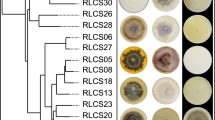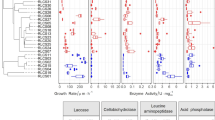Abstract
As decomposer organisms, pathogens, plant symbionts and nutrient cyclers, fungi are of fundamental importance in the terrestrial environment. Moreover, in addition to their well-known applications in industry, many species also have great potential in environmental biotechnology. The study of this important class of organisms is difficult through experimental means alone due to the heterogeneity of their natural growth habitat and the microscopic scale of growth. In this work we present a mathematical model for colony expansion that is derived through consideration of the growth characteristics on the microscale. The model equations are of mixed hyperbolic-parabolic type and are treated with a numerical scheme that preserves positivity and conserves mass. The numerical solutions are compared against experimental results in a variety of environments. Thus the effect of different translocation mechanisms on fungal growth and function are identified. The derivation and analysis of an approximation to the full model yields further results concerning basic properties of mycelial growth. Finally, the acidification of the growth habitat is considered and the model thus provides important predictions on the functional consequences of the redistribution of internally-located material.
Similar content being viewed by others
References
Alexander, M. (1994). Biodegradation and Bioremediation, London: Academic Press.
Alexopolous, C. J., C. W. Mims and M. Blackwell (1996). Introductory Mycology, 4th edn, New York: John Wiley and Sons.
Bailey, D. J., W. Otten and C. A. Gilligan (2000). Saprophytic invasion by the soil-borne fungal plant pathogen Rhizoctonia solani and percolation thresholds. New Phytologist 146, 535–544.
Boddy, L. (1999). Saprotrophic cord-forming fungi: meeting the challenge of heterogeneous environments. Mycologia 91, 13–32.
Boswell, G. P., H. Jacobs, F. A. Davidson, G. M. Gadd and K. Ritz (2002). Functional consequences of nutrient translocation in mycelial fungi. J. Theor. Biol. 217, 459–477.
Boswell, G. P., H. Jacobs, F. A. Davidson, G. M. Gadd and K. Ritz (2003). A positive numerical scheme for a mixed-type partial differential equationmodel for fungal growth. Appl. Math. Comput. 138, 41–60.
Britton, N. F. (1986). Reaction Diffusion Equations and their Application to Biology, New York: Academic Press.
Burgstaller, W. and F. Schinner (1993). Leaching of metals with fungi. J. Biotechnol. 27, 91–116.
Cartwright, D. K. and H. W. Spurr (1998). Biological control of Phytophthora parasitica var. nicotianae on tobacco seedling with non-pathogenic binucleate Rhizoctonia fungi. Soil Biol. Biochem. 30, 1879–1884.
Davidson, F. A. (1998). Modelling the qualitative response of fungal mycelia to heterogeneous environments. J. Theor. Biol. 195, 281–292.
Davidson, F. A. and S. Olsson (2000). Translocation induced outgrowth of fungi in nutrient-free environments. J. Theor. Biol. 205, 73–84.
Davidson, F. A., B. D. Sleeman, A. D. M. Rayner, J. W. Crawford and K. Ritz (1996). Context-dependent macroscopic patterns in growing and interacting mycelial networks. Proc. R. Soc. Lond., Biol. Sci. 263, 873–880.
Dix, N. J. and J. Webster (1995). Fungal Ecology, London: Chapman and Hall.
Edelstein, L. (1982). The propagation of fungal colonies: a model for tissue growth. J. Theor. Biol. 98, 679–701.
Edelstein, L. and L. A. Segel (1983). Growth and metabolism in mycelial fungi. J. Theor. Biol. 104, 187–210.
Edelstein-Keshet, L. and B. Ermentrout (1989). Models for branching networks in two dimensions. SIAM J. Appl. Math. 49, 1136–1157.
Fomina, M., K. Ritz and G. M. Gadd (2000). Negative fungal chemotropism to toxic metals. FEMS Microbiol. Lett. 193, 207–211.
Gadd, G. M. (1992). Microbial control of heavy metal pollution, in Microbial Control of Pollution, J. C. Fry, G. M. Gadd, R. A. Herbert, C. W. Jones and I. Watson-Craik (Eds), Cambridge: Cambridge University Press, pp. 59–88.
Gadd, G. M. (1993). Interactions of fungi with toxic metals. New Phytologist 124, 25–60.
Gadd, G. M. (1999). Fungal production of citric and oxalic acid: importance in metal speciation, physiology and biogeochemical processes. Adv. Microb. Physiol. 41, 47–92.
Gadd, G. M. (Ed.) (2001). Fungi in Bioremediation, Cambridge: Cambridge University Press, p. 481, ISBN: 0-521-78119-1.
Gadd, G. M. and J. Sayer (2000). Fungal transformations of metals and metalloids, in Environmental Microbe-Metal Interactions, D. R. Lovley (Ed.), Washington: American Society for Microbiology, pp. 237–256.
Gadd, G. M. and C. White (1993). Microbial treatment of metal pollution—a working biotechnology? Trends Biotechnol. 11, 353–359.
Garrill, A. (1995). Transport, in The Growing Fungus, N. A. R. Gow and G. M. Gadd (Eds), London: Chapman and Hall, pp. 163–181.
Gerisch, A., D. F. Griffiths, R. Weiner and M. J. Chaplain (2001). A positive splitting method for mixed hyperbolic-parabolic systems. Numer. Methods Part. Diff. Eqns 17, 152–168.
Gerisch, A. and R. Weiner (2003). On the positivity of low order explicit Runge-Kutta schemes applied in splitting methods. Comput. Math. Appl. (in press).
Gooday, G. W. (1975). Chemotaxis and chemotrophism in fungi and algae, in Primitive Sensory and Communication Systems, M. J. Carlile (Ed.), London: Academic Press, pp. 155–204.
Gooday, G. W. (1995). The dynamics of hyphal growth. Mycol. Res. 99, 385–394.
Gow, N. and G. M. Gadd (Eds.) (1995). The Growing Fungus, London: Chapman and Hall.
Heath, I. B. (1990). Tip Growth in Plants and Fungi, London: Academic Press.
Hundsdorfer, W., B. Koren, M. van Loon and J. G. Verwer (1995). A positive finite-difference advection scheme. J. Comput. Phys. 117, 35–46.
Jacobs, H., G. P. Boswell, F. A. Harper, K. Ritz, F. A. Davidson and G. M. Gadd (2002a). Solubilization of metal phosphates by Rhizoctonia solani. Mycol. Res. 106, 1468–1479.
Jacobs, H., G. P. Boswell, K. Ritz, F. A. Davidson and G. M. Gadd (2002b). Solubilization of calcium phosphate as a consequence of carbon translocation by Rhizoctonia solani. FEMS Microbiol. Ecol. 40, 65–71.
Jin, X., C. K. Hayes and G. E. Harmon (1992). Principles in the development of biological control systems employing Trichoderma species against soil-borne plant pathogenic fungi, in Frontiers in Industrial Mycology, G. F. Leatham (Ed.), London: Chapman and Hall, pp. 174–195.
LeVeque, R. J. (1992). Numerical Methods for Conservation Laws, Lectures in Mathematics, ETH Zürich, Basel: Birkhäuser.
LeVeque, R. J. (1996). High-resolution conservative algorithms for advection in incompressible flow. SIAM J. Numer. Anal. 33, 627–665.
Littlefield, L. J., R. D. Wilcoxson and T. W. Sudia (1964). Translocation of Phosphorus-32 in Rhizoctonia solani. Phytopathology 55, 536–542.
McCabe, P. M., M. P. Gallagher and J. W. Deacon (1999). Microscopic observation of perfect hyphal fusion in Rhizoctonia solani. Mycol. Res. 103, 487–490.
Metting, F. B. (1992). Structure and physiological ecology of soil microbial communities, in Soil Microbial Ecology, Applications and Environmental Management, F. B. Metting (Ed.), New York: Marcel Dekker, pp. 3–25.
Morley, G. F., J. A. Sayer, S. C. Wilkinson, M. M. Gharieb and G. M. Gadd (1996). Fungal sequestration, solubilization and transformation of toxic metals, in Fungi and Environmental Change, J. C. Frankland, N. Magan and G. M. Gadd (Eds), Cambridge: Cambridge University Press, pp. 235–256.
Murray, J. D. (1989). Mathematical Biology, 2nd edn, London: Springer.
Ogoshi, A. (1987). Ecology and pathology of anastomosis and intraspecific groups of Rhizoctonia solani Kühn. Annu. Rev. Phytopathol. 25, 125–143.
Olsson, S. (1994). Uptake of glucose and phosphorus by growing colonies of Fusarium oxysporum as qualified by image analysis. Exp. Mycol. 18, 33–47.
Olsson, S. (1995). Mycelial density profiles of fungi on heterogeneous media and their interpretation in terms of nutrient reallocation patterns. Mycol. Res. 99, 143–183.
Olsson, S. and D. H. Jennings (1991). A glass fibre filter technique for studying nutrient uptake by fungi: the technique used on colonies grown on nutrient gradients of carbon and phosphorus. Exp. Mycol. 15, 292–301.
Otten, W., C. A. Gilligan, C. W. Watts, A. R. Dexter and D. Hall (1999). Continuity of air-filled pores and invasion thresholds for a soil-borne fungal plant pathogen, Rhizoctonia solani. Soil Biol. Biochem. 31, 1803–1810.
Paustian, K. and J. Schnürer (1987). Fungal growth response to carbon and nitrogen limitation: a theoretical model. Soil Biol. Biochem. 19, 613–620.
Persson, C., S. Olsson and H.-B. Jansson (2000). Growth of Arthrobotrys superba from a birch wood food base into soil determined by radioactive tracing. FEMS Microbiol. Ecol. 31, 47–51.
Prosser, J. I. (1995). Mathematical modelling of fungal growth, in The Growing Fungus, N. A. R. Gow and G. M. Gadd (Eds), London: Chapman and Hall, pp. 319–335.
Prosser, J. I. and A. P. J. Trinci (1979). A model for hyphal growth and branching. J. General Microbiol. 111, 153–164.
Ritz, K. (1995). Growth responses of some soil fungi to spatially heterogeneous nutrients. FEMS Microbiol. Ecol. 16, 269–280.
Ritz, K. and J. W. Crawford (1990). Quantification of the fractal nature of colonies of Trichoderma viride. Mycol. Res. 94, 1138–1141.
Roe, P. L. (1986). Characteristic-based schemes for the Euler equations. Ann. Rev. Fluid Mechanics 18, 337–365.
Segel, L. A. (Ed.) (1980). Mathematical Models in Molecular and Cellular Biology, Cambridge, U.K.: Cambridge University Press.
Sietsma, J. H., H. A. B. Wosten and J. G. H. Wessels (1995). Cell wall growth and protein secretion in fungi. Can. J. Botany 73(Suppl. 1), S388–S395.
Sweby, P. K. (1984). High resolution schemes using flux limiters for hyperbolic conservation laws. SIAM J. Numer. Anal. 21, 995–1011.
Thornton, C. R. and C. A. Gilligan (1999). Quantification of the effect of the hyperparasite Trichoderma harzianum on the saprotrophic growth dynamics of Rhizoctonia solani in compost using a monoclonal antibody-based ELISA. Mycol. Res. 103, 443–448.
Tobin, J. M., C. White and G. M. Gadd (1994). Metal accumulation by fungi—applications in environmental biotechnology. J. Ind. Microbiol. 13, 126–130.
Trujillo, E. E. (1992). Bioherbicides, in Frontiers in Industrial Mycology, G. F. Leatham (Ed.), London: Chapman and Hall, pp. 196–211.
Wainwright, M. (1988). Metabolic diversity of fungi in relation to growth and mineral cycling in soil—a review. Trans. British Mycol. Soc. 90, 159–170.
Watters, M. K. and A. J. F. Griffiths (2001). Tests of a cellular model for constant branch distribution in the filamentous fungus Neurospora crassa. Appl. Environ. Microbiol. 67, 1788–1792.
Wessels, J. G. H. (1993). Wall growth, protein excretion and morphogenesis in fungi. New Phytologist 123, 397–413.
Whipps, J. M. (2001). Microbial interactions and biocontrol in the rhizosphere. J. Exp. Botany 52, 487–511.
Author information
Authors and Affiliations
Corresponding author
Rights and permissions
About this article
Cite this article
Boswell, G.P., Jacobs, H., Davidson, F.A. et al. Growth and function of fungal mycelia in heterogeneous environments. Bull. Math. Biol. 65, 447–477 (2003). https://doi.org/10.1016/S0092-8240(03)00003-X
Received:
Accepted:
Issue Date:
DOI: https://doi.org/10.1016/S0092-8240(03)00003-X




